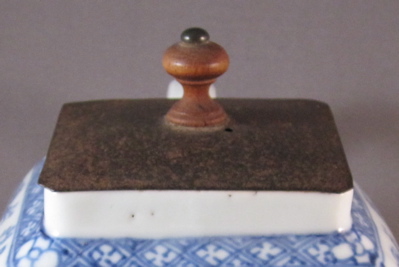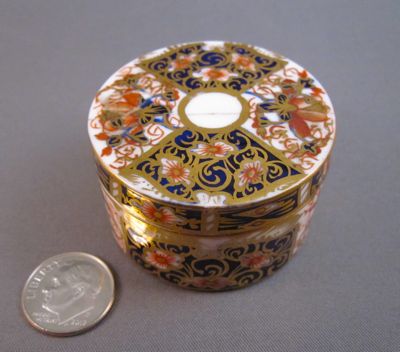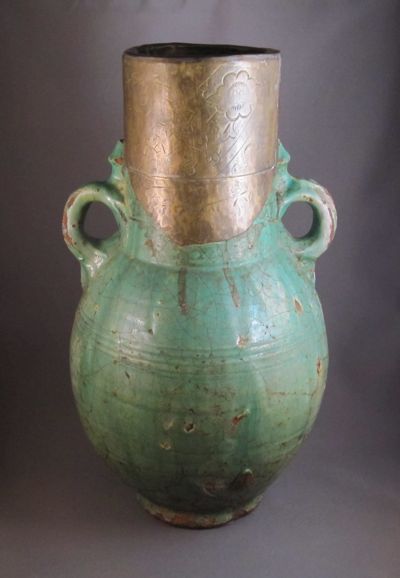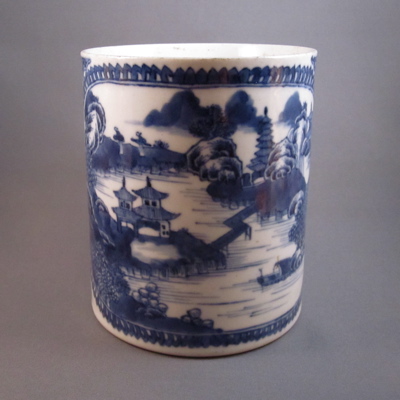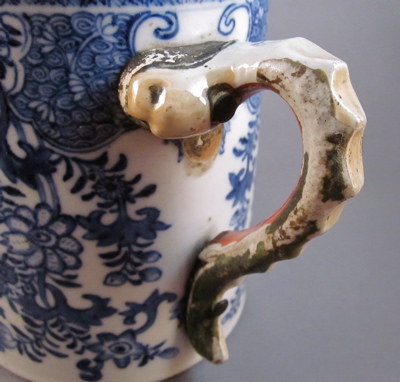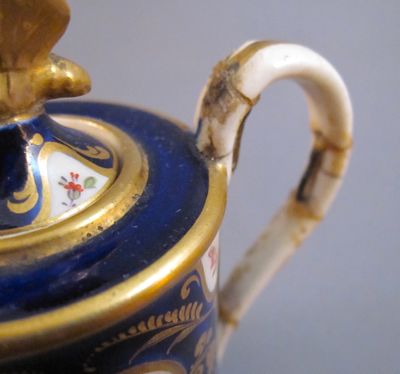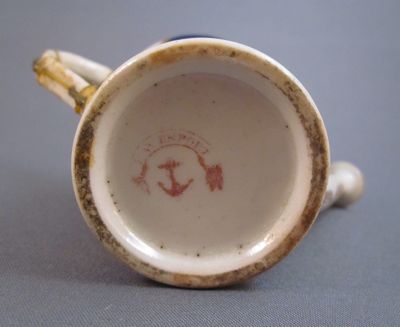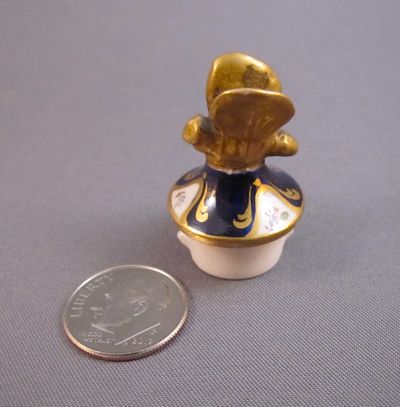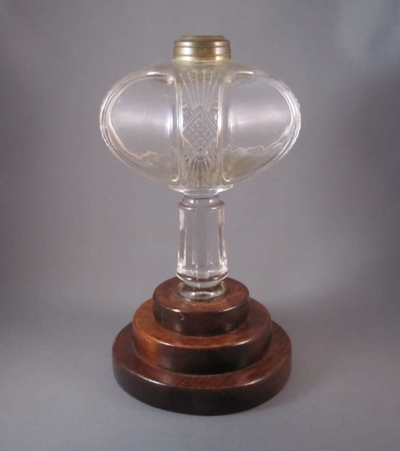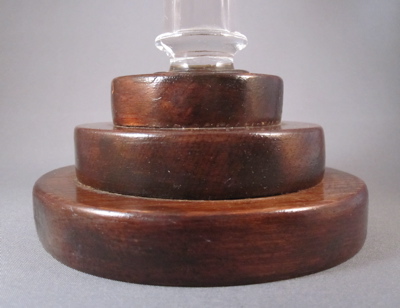I am a sucker for a double “make-do” and this one delivers a one-two punch! This thick-walled porcelain teapot was made in China during the Yongzheng period (1722-1735) and boasts an unusual square-paneled, bombe form. It is delicately decorated with a blue floral motif and measures 5″ high by 7″ wide from spout to handle. At some point in its early life it was regrettably dropped, breaking the spout and rendering it unusable. Luckily a silversmith was able to fashion a finely made replacement spout and once again the tea flowed. That is until many years later when the lid dropped. This time a tinsmith created a new metal replacement, incorporating a small turned-wood knob as a stand-in finial. The replacement lid is much cruder than the new spout and I believe about a century separates the two repairs. Although I pity the people who let the teapot and lid slip from their grasps, I am glad the owners had the good sense to remedy their unfortunate situations and repair both pieces in such an interesting fashion.
Derby porcelain ointment box, c.1905
January 19th, 2013This tiny porcelain ointment box was made in England by Royal Crown Derby in the early 1900s. Standing a mere 1″ tall and with a diameter of 1-3/4″, it is one of the smallest antiques with inventive repairs I own. It is nicely hand decorated in the Imari pattern with classic cobalt blue, red and gilt enamels. The “V” mark on the bottom of both the lid and base dates this wee box to 1905. The underside of the lid reveals three metal staples, graduating in size from 1/4″ to 3/8″ long, which hold the two broken halves tightly together.
Mystery vessel with incised brass collar
January 12th, 2013I purchased this large and extremely heavy ceramic vessel about one year ago from a dealer who knew absolutely nothing about it. In the ensuing months, I have tried my best to research its country of origin and age, only to come to a screeching halt. A friend who works at the Metropolitan Museum of Art forwarded the photos on to a couple of experts in their fields and the results were less than satisfying. His response was: “The Islamic folks think it looks Ancient Near Eastern and the Ancient Near East folks think it looks Islamic”. I then sent the photos to a collector of ancient Chinese ceramics living in Hong Kong who had this to say: “…my personal thinking it maybe an old piece, possibly around Yuan-Ming 14th-17th century from the cutting of foot rim, glaze and the shape. You can imagine..how much there we spent times and money just to repaired by brass to mouth rim. We must used logically consideration. Last but not least, I predicted it’s from some kind small kilns in China which just a few people can identified…”. Hmm.
These are the facts I do know: the vessel has a distressed green crackle glaze over a red clay pottery body. It measures 14″ high, has an opening of 4-1/4″ and is 8″ wide from handle to handle. An asymmetrical brass collar with an incised floral pattern is covering most of the neck, presumably masking a damaged top. As far as the repair goes, it seems to be of Middle Eastern design, possibly Turkish.
I would greatly appreciate any information anyone may have to help me identify this truly puzzling piece.
American brass bell, c.1900
January 6th, 2013This whimsical yet simple double repair gives a new meaning to Yankee ingenuity. What do you do when both the handle and the clapper of a small brass bell from the early 1900s are no longer functional? First you grab a wooden handle from an old rubber stamp and reattach it to the crown of the bell. Then you find a brass Civil War Navy uniform button and fasten it to the inside of the bell, which is just what an enterprising person did to their broken bell in New England sometime in the early part of the 20th century. So thanks to them, I am now able to ring in the new year with my make-do bell. Happy 2013!
Season’s Greetings
December 23rd, 2012Clobbered Canton plate, c.1800
December 9th, 2012This Chinese porcelain plate started out life in the early 1800s with traditional blue underglaze Canton decoration. It was later painted over or “clobbered” with overglaze washes of red, green enamels and gilt highlights, without much thought to the original plate’s decoration. As the demand for more colorful wares increased throughout Europe, enterprising merchants painted over their slow selling blue and white ceramics. Much of the over decorating was done in the Netherlands, where the pieces were referred to as “Amsterdams Bont” (colorful wares from Amsterdam) . Plate measures 8-3/4″ in diameter.
After the plate dropped and broke in to 4 pieces, it was made whole again by the addition of 9 metal staples.
A “Chinese” mark on the bottom is actually part of the Dutch clobbered decoration.
This Canton plate shows what mine looked like before it was embellished.
Photo courtesy of Antique Helper
Chinese-English “monster mug”, c.1780
November 24th, 2012This is the story of a forced marriage between an 18th century Chinese porcelain mug and a 19th century English pottery jug, joined together by a mad tinker to live out the rest of their lives as one. The Qianlong period (1736-1795) mug with cobalt blue underglaze design stands 5-1/8″ high. The original handle, most likely in the form of a dragon, broke off sometime in the early 1800s. I imagine a clever repairer (or Dr. Frankenstein?) found a damaged English stoneware pottery jug, skillfully removed the intact snake-shaped handle and, using two metal rivets, reattached it to the body of a Chinese tankard…creating a hybrid Anglo-Asian monster mug!
This is what the original dragon handle on my Chinese mug would have looked like before it broke off. Photo courtesy of Ruby Lane
And this Mason’s Ironstone “Hydra” jug, made in Staffordshire, c.1830, shows the serpent handle intact. Photo courtesy of Selling Antiques
Miniature Davenport watering can, c.1860
November 10th, 2012English porcelain miniature watering can made by Davenport in the mid-1800s. Finely painted with multicolor floral and scrollwork design with gilt accents. Measures 2-3/4″ high to tip of moth form lid finial and is 3-1/2″ wide from end to end. Stamped in red with DAVENPORT in a banner with an anchor, dating it from 1850 to 1870. Three brass staples on the handle, with the aid of some sloppily applied glue, hold the three broken pieces back together again.
Glass kerosene oil lamp, c.1860
November 4th, 2012Early American Pattern Glass (EAPG) kerosene oil lamp in what appears to be the Hamilton (aka Cape Cod) pattern, made in America by the Cape Cod Glass Company circa 1860. Measures 8-3/4″ tall. Round 3 tier base of polished wood replaces the original glass base, broken many years ago and replaced in first quarter of the 20th century.




